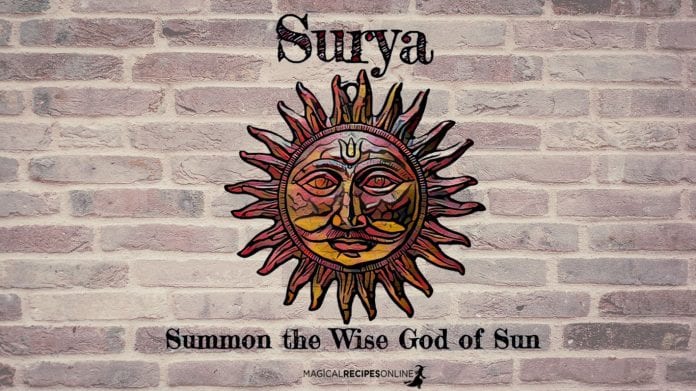As I have said in the post regarding the Sun in Vedic Astrology, Lord Surya is the God that rules its influence. Lord Surya is a son of Aditi, who is the mother of Adityas (sons of Aditi), a class of solar deities.
The father of Surya was Kasyap, who is considered to be one of the Seven Great Sages (Saptarishi), although we should mention that the Vedas do call upon them but never mention them all by name.
Although in the beginning Mitra seems to be the chief of the Adityas, soon Surya was considered the chief of them and finally became the Aditya, embodying all the Adityas in Himself. The first one to be considered as another form of Surya was Savitar, whose descriptions in the Rig Veda is quite the same, in most aspects, as Surya’s.
Before 300 B.C., when the followers of Vishnu and therefore vaishnavism (the path of Hinduism dedicated to Great Lord Vishnu) expanded, there were three (instead of two as it happens nowadays) main paths shaivism (the path dedicated to Great Lord Siva), vaishnavism, and the one dedicated to Lord Surya. For them Lord Surya is Brahma in the morning, Vishnu during the day and Siva during the night. The great popularity of Lord Surya is obvious of the many hymns dedicated to him (under the name Surya, or Savitar) in the Rig Veda, and the even more hymns that call upon him (as Surya, Savitar or Aditya), as well as his “key roles” in both the Ramayana and the Mahabharata. Even the dynasty of Lord Rama claims to descend from Lord Surya.
Surya is pictured, usually with one head, and two or four arms. Most of the times he holds a lotus flower on one hand and a spinning swastika in another – a solar symbol, symbolising, amongst other things, the everlasting circle of time. In his more fighting forms he also holds a mace.
He usually sits in his chariot, which has seven horses, representing the seven colours of the rainbow, although sometimes it is one horse with seven heads. In some cases, there are two horses, but, in fact, this is the form of Savitar. The Rig Veda calls upon him as eye of Mitra, Varuna and Agni, (Spotted) Bull, and Bird. In fact the form of Ravi (Fire Bird) may be the same as Phoenix, although Lord Garuda also may be the Phoenix.
Lord Surya has three wives (or four, although the fourth is the shadow of the first) and he has 8 divine sons, among them Lord Yama (the God of Death), Lord Shani (the Graha God of Saturn) and the twins Ashvins (the Sunrise and Sunset), and 3 daughters among them Yami (Goddess of Death), twin sister of Lord Yama.
He also had a mortal son, Karna, who was born from the virgin princess Kunti. The Mahabharata says that princess Kunti learned a mantra by which she could call upon any God and have a child with him. She tried it with Lord Surya. Surya appeared in front of her, and the princess was scared and told him to leave. Because of the mantra, though, Surya had to give her a child. Respecting the fact that she was an unmarried princess she made her pregnant without sex. And that’s how Karna was born. The story somehow is similar with the story concerning the birth of Dionysus and Jesus Christ.
Lord Surya is a very loving God, and cares for everyone. In addition to magnify the beneficial aspects of Sun and minimize the malefic ones, one may call Lord Surya for protection against evil entities and against black magic, protection against vampires, blood sucking and energy sucking alike, for obtaining wealth, and happiness and also for healing and for good health. I should say that Ashvins are the devas of Ayurvedic medicine.
In addition of the mantras given in the previous post, and the magic square of the Sun, one can praise Lord Surya using the Surya Namaskara.
Although most people practising Hatha Yoga know that Surya Namaskara means Sun Salutation, in fact it means Prayer to Surya. And whoever practises Hatha Yoga, knows that it is a series of yoga postures. It is also a series of mantras. I have seen versions of the Surya Namaskara exercise that includes different number of postures, sometimes as many as 24. Maybe it is really good gymnastics, but I would choose a 12 posture procedure as 12 are the mantras of the Surya Namaskara prayer.

Here I am not going to describe the Hatha Yoga postures, but only the mantras. A recitation of the twelve mantras is a complete prayer. Nine repetitions of the twelve mantras (9*12=108) is also a complete prayer. A hundred and eight repetitions of the twelve mantras are also a complete prayer, so choose what you want. If you are performing the Hatha Yoga’s exercises, mentally repeat one mantra for each posture, starting with the first mantra during the namaskara posture. Remember not to perform the Surya Namaskara procedure when you want to sleep, as it is a rather energizing procedure. And also ask your physician before performing the procedure. Of course you don’t need to take your doctor’s advice for the prayer, but also perform it during rising, midday or setting. Karna used to do it every noon.
Now start from mantra 1 to mantra 12 and then, if you want, start from mantra 1 to 12 again. Don’t repeat nine times the first mantra, then nine times the second and so on. In the parenthesis there is the seed sound of the mantra. You can either include it, or not. Also, after the dash, it’s the English explanation of the name. The mantras end with the “namah”, so you should not include the explanation in your repetitions.
- Om (Hram) Mitraya namah – Friend
- Om (Hreem)Ravaye namah – Fire Bird
- Om (Hrum) Suryaya namah – Supreme Light
- Om (Hraim) Bhanave namah – Light
- Om (Hraum) Khagaya namah – He who enters everywhere
- Om (Hrah) Pushne namah – He who causes growth
- Om (Hram) Hiranyagarbhaya namah – Golden Egg
- Om (Hreem) Marichaye namah – Ray of light
- Om (Hrum) Adityaya namah – Son of Aditi
- Om (Hraim) Savitre namah – Life giver
- Om (Hraum) Arkaya namah – Ray
- Om (Hrah) Bhaskaraya namah – Creator of Light
Let the Sun shine brightly in your life.

